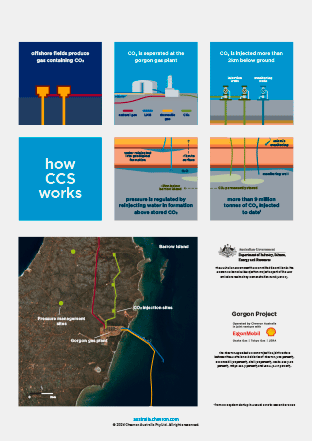gorgon carbon capture and storage
reducing greenhouse gas emissions for a lower carbon future

We believe the future of energy is lower carbon and that affordable, reliable, and cleaner sources of energy are essential to achieving a more prosperous and sustainable world.
Carbon capture and storage (CCS) is a proven technology for reducing greenhouse gas emissions (GHG). It's critical to a lower carbon future and essential to achieving the net zero goals of the Paris Agreement.
CCS takes naturally occurring carbon dioxide (CO2) from industrial processes and permanently traps it in geological formations deep underground. We’re proud that the world’s largest CCS system designed to capture carbon emissions is located at our Gorgon liquefied natural gas (LNG) facility on Barrow Island.
the gorgon CCS system prevents millions of tonnes of greenhouse gases being vented into the atmosphere
More than 11 million tonnes of CO2 injected to date1

More than 100 million tonnes of CO2 expected to be mitigated over the life of the CCS system
Naturally occurring CO2 is taken from offshore gas reservoirs and injected into a giant sandstone formation two kilometres under Barrow Island, where it remains permanently trapped.
The Gorgon CCS system started up safely in August 2019 and will continue to be optimised to ensure it performs reliably over 40-plus years of operation.
Chevron is committed to sharing the lessons we've learned in developing the Gorgon CCS system with state and federal governments, research institutes and other energy producers to support the deployment of CCS technology in Australia.
[1] from CCS system startup in August 2019 to May 2025.
optimisation works at gorgon CCS

Chevron Australia is committed to increasing carbon dioxide injection rates at Gorgon CCS in accordance with its environmental approvals.
A project has commenced that aims to expand the system’s capacity to manage water found within the reservoir where carbon dioxide is stored, thereby reducing reservoir pressure and enabling increased carbon dioxide injection rates.
The project consists of optimising existing infrastructure through the:
- modification of four existing water producing wells to expand reservoir water extraction capability,
- installation of new surface infrastructure to enhance water processing,
- modification of two existing water injection wells to increase the volume and flow rate of water that can be processed, and
- drilling of two new water injection wells to increase the total volume of water that can be processed.
In addition to this project, Chevron Australia continues to explore options to further increase carbon dioxide injection rates within the system.

